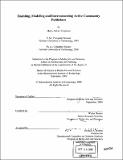| dc.contributor.advisor | Walter Bender. | en_US |
| dc.contributor.author | Turpeinen, Marko Sakari, 1968- | en_US |
| dc.contributor.other | Massachusetts Institute of Technology. Dept. of Architecture. Program In Media Arts and Sciences. | en_US |
| dc.date.accessioned | 2011-05-09T15:11:39Z | |
| dc.date.available | 2011-05-09T15:11:39Z | |
| dc.date.copyright | 2000 | en_US |
| dc.date.issued | 2000 | en_US |
| dc.identifier.uri | http://hdl.handle.net/1721.1/62631 | |
| dc.description | Thesis (S.M.)--Massachusetts Institute of Technology, Program in Media Arts & Sciences, 2000. | en_US |
| dc.description | Includes bibliographical references (leaves 63-66). | en_US |
| dc.description.abstract | Over the past four years the research described in this thesis has enabled community groups to become collaborative content producers on the Internet. These groups use computer-mediated networking to publish their stories and to enhance the interaction among the community members and their peers in other groups. This research has resulted in a community publishing tool called Pluto and its revision called Goofy that is nearing its completion. Further, the growth of these communities has led to the need for another system, called SilverWire, to facilitate interaction among communities. SilverWire is a tool for increasing socialization and augmenting communication among communities that actively publish content on the Internet. SilverWire collects and builds models of communities, which form the basis for customized interconnections among communities. Community models are built implicitly by analyzing the contents of the sites that take part in SilverWire and are collected explicitly from questions asked about community purpose, identity and communication. As a result, SilverWire recommends pointers to related community publications and provides comparisons between communities. The goal of the SilverWire system is to be an intermediary that makes communities more aware of other communities doing similar (or interestingly different) work. To evaluate the project I report in detail the progress of one of the groups called the Silver Stringers, which is a local community consisting of approximately 30 senior citizens. The main impacts of the project for the Silver Stringers have been (1) acquiring a new mindset in becoming media content producers, (2) continuous mental stimulation through learning and creating in a group setting, and (3) increased social interaction. | en_US |
| dc.description.statementofresponsibility | by Marko Sakari Turpeinen. | en_US |
| dc.format.extent | 82 leaves | en_US |
| dc.language.iso | eng | en_US |
| dc.publisher | Massachusetts Institute of Technology | en_US |
| dc.rights | M.I.T. theses are protected by
copyright. They may be viewed from this source for any purpose, but
reproduction or distribution in any format is prohibited without written
permission. See provided URL for inquiries about permission. | en_US |
| dc.rights.uri | http://dspace.mit.edu/handle/1721.1/7582 | en_US |
| dc.subject | Architecture. Program In Media Arts and Sciences. | en_US |
| dc.title | Enabling, modeling and interconnecting active community publishers | en_US |
| dc.type | Thesis | en_US |
| dc.description.degree | S.M. | en_US |
| dc.contributor.department | Program in Media Arts and Sciences (Massachusetts Institute of Technology) | |
| dc.identifier.oclc | 48591250 | en_US |
